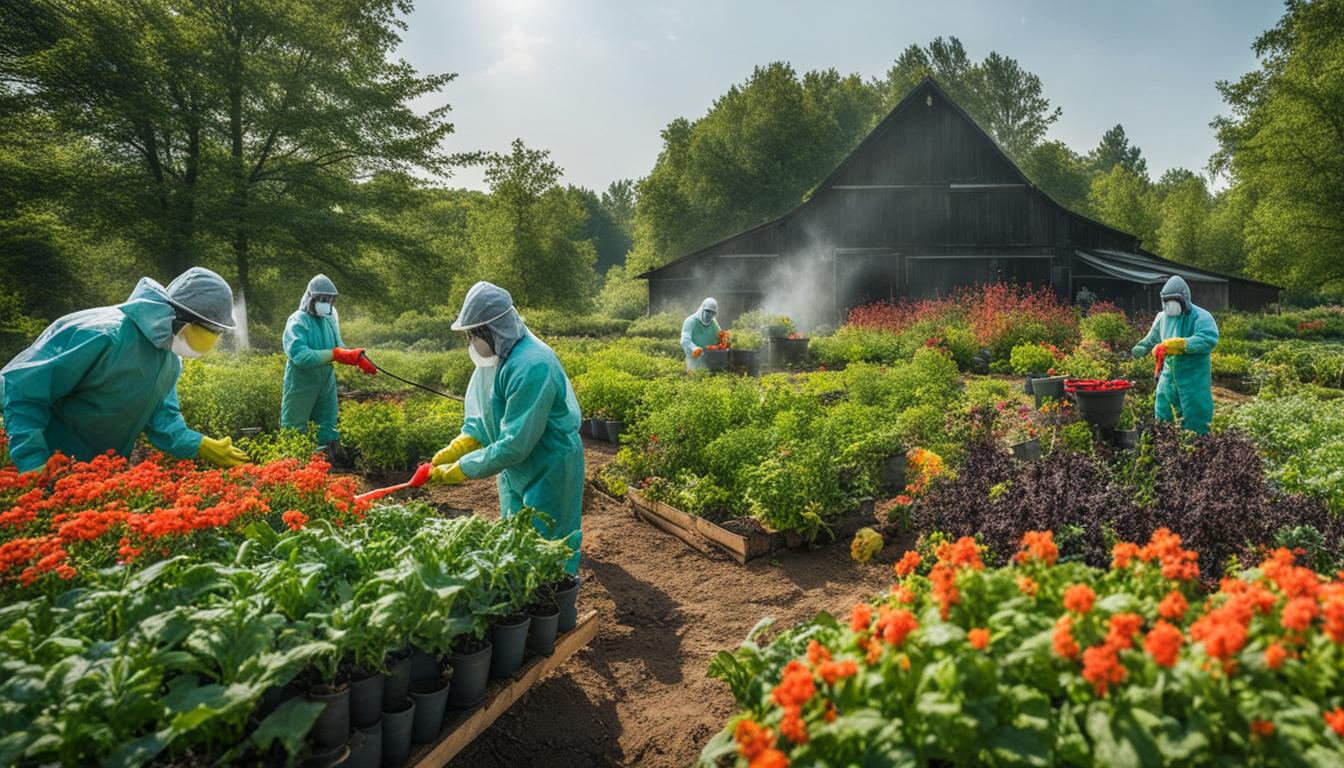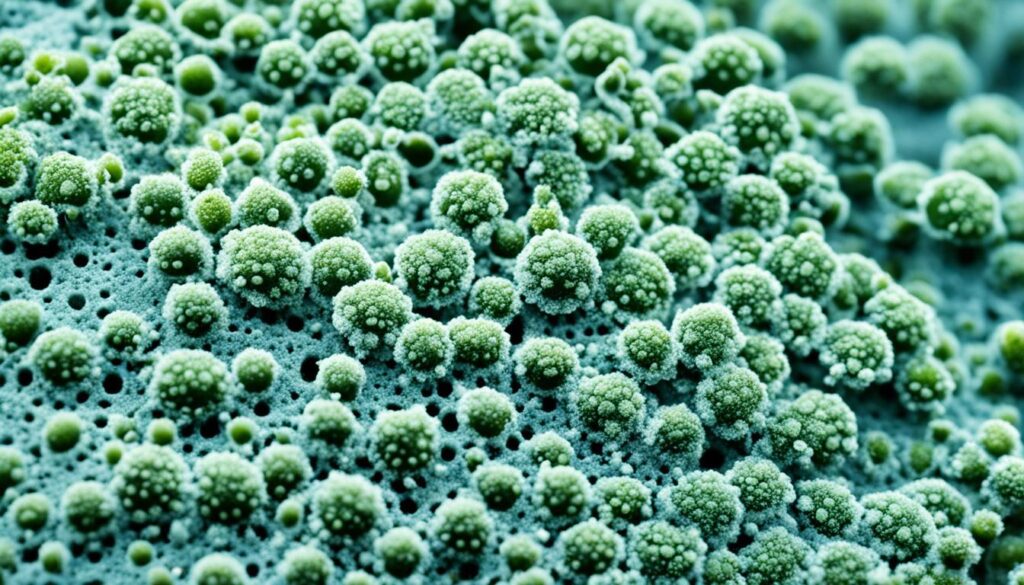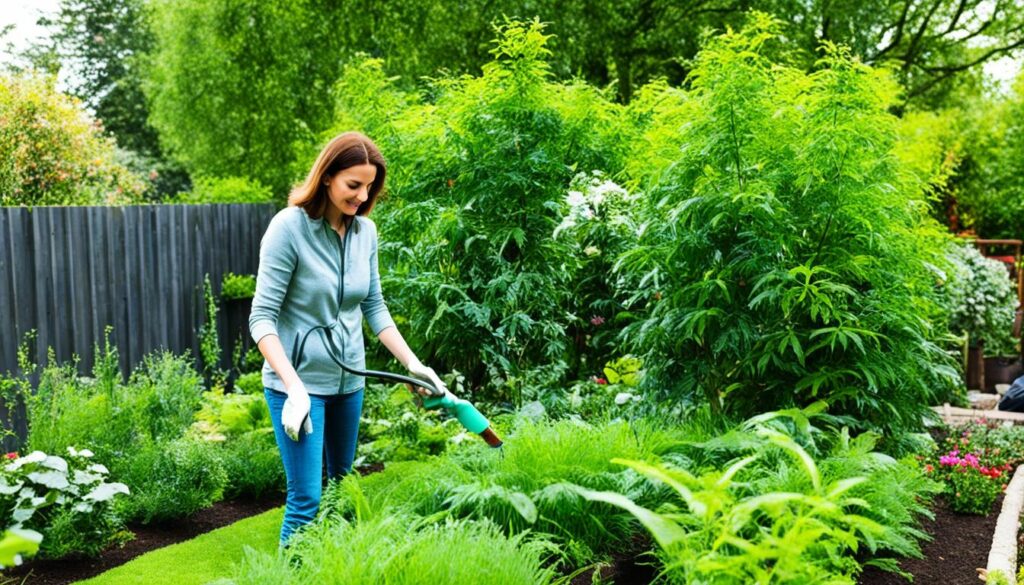
Effective Grey Mold Treatment Strategies
Grey mold, also known as Botrytis cinerea, is a common fungal disease that can wreak havoc on your beloved plants. If left untreated, it can quickly spread and cause significant damage. But fear not, for there are effective strategies that can help you combat this pesky mold and regain control over your green space.
When it comes to treating grey mold properly, it’s essential to take a comprehensive approach. This includes identifying the symptoms, implementing cultural practices, and, if necessary, resorting to chemical controls. By following these treatment strategies diligently, you can prevent the spread of grey mold and safeguard your plants.
Key Takeaways:
- Early identification and prompt action are crucial in treating grey mold.
- Implement cultural practices like proper plant spacing and moisture control to prevent grey mold development.
- If cultural practices are not sufficient, consider using approved fungicides for grey mold treatment.
- Always follow safety guidelines when applying chemical controls.
- Regular monitoring and preventive measures are vital to effective grey mold control.
Identifying Grey Mold Symptoms
Before diving into treatment strategies, it is important to be able to identify the symptoms of grey mold. By recognizing the signs of grey mold infestation in plants, you can take prompt action to address the issue and prevent its further spread.
Common signs of grey mold infestation:
- Greyish, fuzzy mold growth on leaves, stems, flowers, or fruits
- Soft, watery spots that quickly turn to mush
- Browning or wilting of affected plant parts
- Musty odor
It is essential to differentiate grey mold from other fungal diseases that may exhibit similar symptoms. This can ensure that the appropriate treatment methods are applied for effective management.
Differentiating grey mold from other fungal diseases:
Grey mold can be distinguished from other fungal diseases by considering the following:
“Grey mold often starts as small, water-soaked spots that rapidly expand into larger patches. Unlike powdery mildew, which appears as a white, powdery coating, grey mold has a fuzzy, greyish appearance. Additionally, grey mold tends to affect plant tissues that are aging, damaged, or decaying, while other fungal diseases may affect healthy plant parts as well.”
Accurately identifying grey mold symptoms allows you to implement appropriate prevention and treatment measures to manage its impact effectively.

Cultural Practices for Grey Mold Control
Alongside specific treatment methods, implementing cultural practices can greatly reduce the risk of grey mold development. By incorporating these techniques into your gardening routine, you can effectively manage and control grey mold in your plants.
Proper Plant Spacing
One important cultural practice for grey mold prevention is ensuring adequate plant spacing. Overcrowding plants can create a humid and confined environment, ideal for the growth of grey mold. By providing enough space between plants, air can circulate freely, reducing moisture buildup and inhibiting the spread of the fungus.
Adequate Ventilation
Good airflow is essential for managing grey mold in plants. Proper ventilation helps to reduce humidity and promote drying, making it harder for the fungus to thrive. To improve ventilation, consider strategically placing fans in greenhouses or indoor growing areas, and avoid overcrowding plants near obstructions such as walls or other structures.
Moisture Control
Moisture management is crucial in preventing grey mold. Avoid excessive watering, especially on leaves and flowers, as it creates a favorable environment for the fungus. Instead, water plants at their base using drip irrigation or a soaker hose to minimize moisture on the foliage. Additionally, ensure proper drainage in containers and garden beds to prevent waterlogged soil, as damp conditions can contribute to grey mold development.
“Proper plant spacing, adequate ventilation, and moisture control are key cultural practices for managing grey mold in plants.” – Gardening Expert

Implementing these grey mold prevention tips and adopting effective cultural practices can significantly reduce the risk of grey mold development in your garden or indoor plants. By providing suitable conditions for healthy plant growth and avoiding excess moisture, you can create an environment where grey mold is less likely to thrive.
Chemical Controls for Grey Mold Treatment
When cultural practices are not enough to combat grey mold, chemical controls can be a valuable tool in its treatment. Understanding the available fungicides and their proper application methods is crucial for effective grey mold management. However, it is essential to follow proper safety guidelines and utilize approved products when using chemicals for grey mold treatment.
The Importance of Choosing the Right Fungicide
Not all fungicides are equally effective against grey mold, so it is crucial to choose the right one for optimal results. Look for fungicides specifically labeled for grey mold treatment and containing active ingredients such as boscalid, pyrimethanil, or cyprodinil. These fungicides have shown good efficacy against grey mold and can help control its spread.
Pro Tip: Read the product labels carefully and follow the instructions for dosage, application frequency, and safety precautions.
Application Methods for Grey Mold Treatment
There are several application methods you can use to treat grey mold effectively. Choosing the appropriate method depends on the scale of the infestation and the type of plants affected:
- Sprays: Fungicides can be applied through foliar sprays, which coat the plant’s surfaces and help prevent fungal spores from germinating. For the best results, apply the spray thoroughly, covering all plant parts and focusing on areas prone to grey mold development, such as flowers, buds, or fruit.
- Drenches: Drenching the soil with fungicide can be effective when dealing with grey mold in potted plants or indoor gardens. It helps control the disease at the root level and prevents its spread to other parts of the plant.
- Systemic treatments: Some fungicides are designed to be absorbed by the plant and provide long-term protection against grey mold. These systemic treatments offer an added advantage by targeting both existing infections and preventing future ones. Apply the fungicide as directed, ensuring it reaches the plant’s vascular system.
Monitoring and Follow-Up
After applying chemical controls for grey mold treatment, it is crucial to monitor the plants closely for any signs of improvement or recurrence. Grey mold can be persistent, so ongoing vigilance is necessary to ensure its eradication. If the infestation persists or worsens, consider consulting with a professional horticulturist or plant pathologist for further guidance.
Remember, chemical controls should be used as a last resort and in conjunction with cultural practices for holistic grey mold management. By combining these two approaches, you can effectively address grey mold issues and protect your plants from its damaging effects.
Conclusion
In conclusion, effectively treating grey mold requires a combination of cultural practices and, if necessary, chemical treatments. By promptly identifying and addressing grey mold symptoms in your plants, implementing preventive measures, and utilizing appropriate treatment methods, you can successfully manage and control grey mold infestations.
When dealing with grey mold, it is crucial to prioritize prevention. By practicing proper plant spacing, ensuring adequate ventilation, and controlling moisture levels, you can create an environment that is less conducive to the growth and spread of grey mold.
If preventive measures are not enough, chemical controls can be used to treat grey mold effectively. However, it is important to follow safety guidelines and use approved fungicides to minimize any potential harm to the environment, yourself, and your plants.
To treat grey mold properly, it is essential to stay vigilant and regularly inspect your plants for any signs of infestation. Early identification and prompt action can greatly increase your chances of successfully managing grey mold and preserving the health of your plants.




